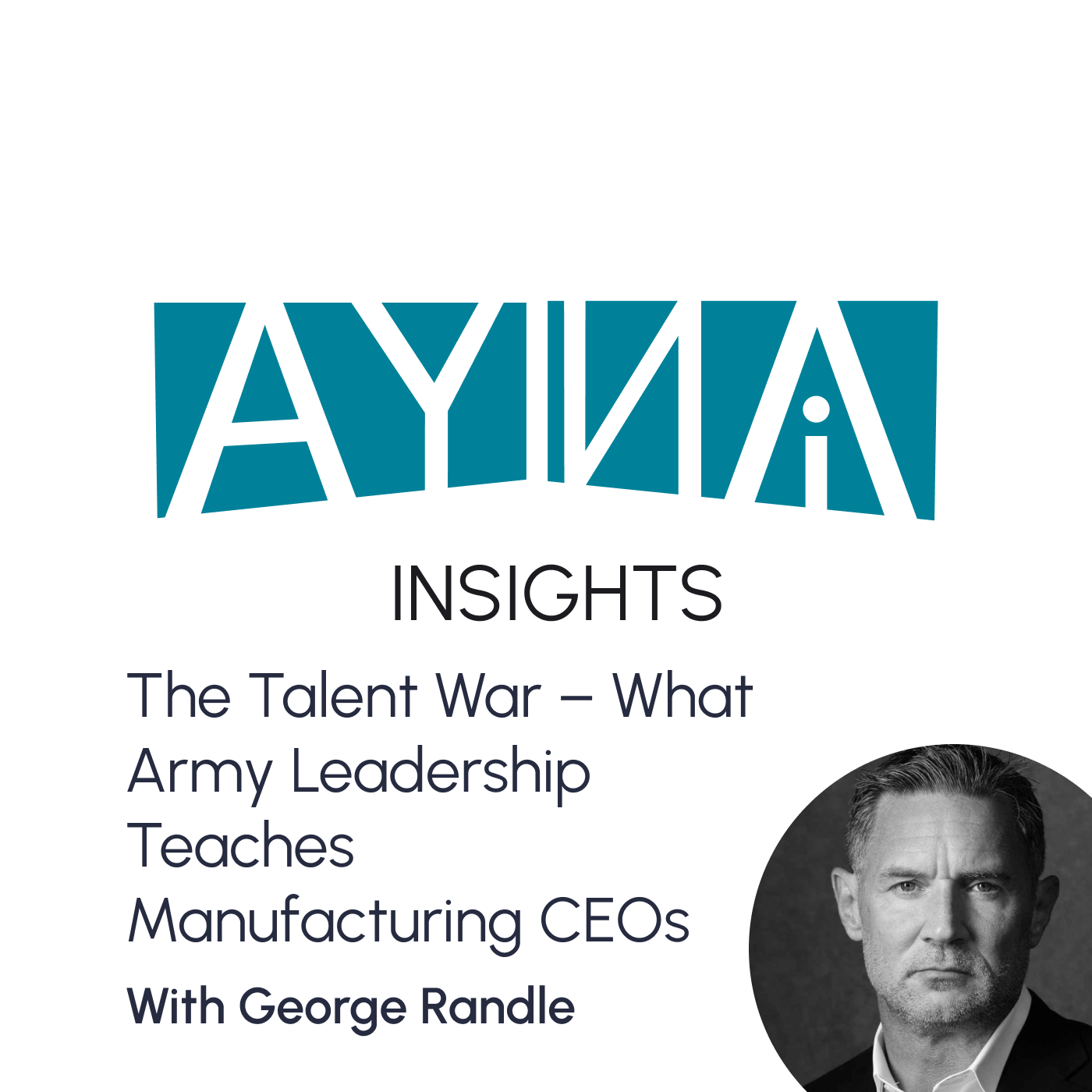Episode Transcript
[00:00:03] Speaker A: Welcome to AINA Insights where prominent leaders and influencers shaping the industrial and industrial technology sector discuss topics that are critical for executives, boards and investors. Aina Insights is brought to you by INA AI, a firm focused on working with industrial companies to make them unrivaled segment of ONE leaders. To learn more about INA AI, please visit our website at www.ina.AI.
[00:00:40] Speaker B: Good morning and welcome to another episode of INA Insights. I'm Dinesh Chopra, President of INA and I'm joined by a seasoned leader in the building products and materials sector, Joe Pyler, President and CEO of Becca Inc.
Joe took the helm of Weka in March 2010 at a time when the North American business was still recovering from the housing downturn and global financial crisis.
Under his leadership, VECA not only stabilized, but strengthened its position as a global leader in windows and door manufacturing.
Before joining weka, Joe served as the CEO of tmi, held senior management roles at Freudenberg Nock, and was Executive Vice President at Ardex, a global specialty building materials company.
He also holds an MBA in Business and Economics from Ruhr University Bochum in Germany. Joe, it's pleasure to have you with us.
[00:01:38] Speaker C: It's a pleasure.
[00:01:41] Speaker B: So Joe, thank you for taking the time. We'll go through and we talk a little bit about the building product sector in general and get your reactions and thoughts about where we are. As you know, over the last few years post Covid, specifically we have seen a challenging macro backdrop.
Interest rates are still high, inflation is sticky or seems to be sticky, yields have been rising. Now the dollar is slightly weaker and most recently this morning you must have seen the labor market also seems to be showing the signs of crack.
So in your view, where do you think we are in the building product sector and what needs to shift in the macro backdrop for the sector to regain momentum?
[00:02:25] Speaker C: Yeah, so I think the number one factor that we're all most concerned about are the interest rates. Right. And I've had a lot of debates with colleagues what would truly move the needle.
I have friends in the banking industry that believe the anticipated quarter point would make a big difference. But I fall into the camp where I believe we need to see 30 year mortgage rates sub 6% to really get people off the sideline and eventually that will happen. The question is, will it happen sooner in 26 or maybe later in 26? I think we're heading in the right direction. Maybe not fast enough.
[00:03:02] Speaker B: Yeah, interest rates definitely are going to be the biggest driver. Hopefully we'll see what happens in September later this month with the rate cuts. What about tariffs?
How are you seeing tariffs impact your business and how have they shown up and for you and even your, I would say your customers.
[00:03:20] Speaker C: Yeah. So we're fortunate that the vast majority, over 95% of our raw materials are sourced domestically. Now what we do keep an eye on is further up in the supply chain. Where do our suppliers source their material? Because that will ultimately come through.
But so far on the material side, it's fairly limited. Where we've seen more of an impact is on the equipment side in our capital expenditure plans. So we utilize a lot of European German technology.
Right. And so the return on investment on some of those initiatives has shifted. Right. And that forces us to reevaluate certain projects. And so the pecking order is changing.
Right. And that favors actually some US technology that is becoming more favorable in an ROI calculation scenario.
[00:04:14] Speaker B: So far from the pricing standpoint, you feel good about where you are, but it just changes the calculus on where you invest and where do you buy your equipment from.
[00:04:26] Speaker C: We're feeling pricing pressure certainly in some pockets. It is fortunately somewhat limited.
The area where actually we're seeing the biggest pressure continues to be in labor and particularly on the healthcare cost, insurance cost side.
That is surprisingly, maybe for some people listening, it's a bigger driver than the tariffs cost.
[00:04:51] Speaker B: Yeah, for sure. Finding labor or finding good labor is hard nowadays and those costs are definitely.
[00:04:57] Speaker C: Going up, especially for skilled labor. That continues to be a challenge. Not so much at the bare entry level right now. Now.
[00:05:06] Speaker B: Yeah, yeah. Shifting. Shifting a little bit to the.
You talked a little bit earlier about the interest rates and the housing shortage. We all know that there is a lot of housing shortage in U.S.
but the new home starts are still not to the level what we would want for it to take care of that shortage and largely due to the interest rate environment.
So as you have thought over the last few years about your. About Vecca's diversification strategy or product strategy, how has that factored into how you plan?
[00:05:43] Speaker C: Yeah, really good challenge. And so our core product, of course, is final window extrusion. And within that, it's important for us that we maintain a balance in terms of our customer portfolio. Companies focusing on new construction, companies focusing on renovation and replacement. Right. We do have an outdoor living products business with fence deck and rail. Right. That isn't always aligned from a cyclicality point of view. So that does help. And then there's also a geographic diversification. We're seeing certainly slowdowns in new construction. Heavy markets have been flying high in the Prior years.
Right. Whereas in the Midwest, for example, you have a much tighter bandwidth and a greater reliance on renovation and replacement. And those markets are a lot more stable than the boom that we've seen in Florida, the boom that we've seen in Texas. There's certainly a deceleration in activity in those markets.
[00:06:43] Speaker B: Yeah. So where are you seeing within your product categories higher growth versus less? Is it like repair Remodeling is growing steady, whereas new construction is down. How would you characterize which segment, sub segment is growing faster versus less, and which geography now is growing faster versus less? If you have to paint that picture.
[00:07:05] Speaker C: Yeah. So we're seeing really a very solid performance in the Midwest market.
Right. And that is in part thanks to the fact that we are partnered with some market leaders, and those market leaders consistently have outperformed their peers.
And so being linked to these fantastic companies, that has allowed us to outperform the market.
Got it.
[00:07:32] Speaker B: That's helpful. As you see next couple of years to shape in the building product sector, what tailwind do you see shaping up?
[00:07:43] Speaker C: I'm actually quite optimistic. When I look at the next five years, I think the demographics will favor us. You have a generation that is already at the beginning of home buying age, and there's delayed adolescence happening, but eventually they have to move out of the basement. And that is increasingly happen. And it will happen when interest rates come down just a little bit more.
And then another important factor is the aging housing stock. That is something that continues to build and that will continue to drive the need for renovation business.
Yeah.
[00:08:20] Speaker B: So definitely. So you're saying demographic shift and then continuous tailwind in the repair and remodeling sector are the two pockets of growth you continue to see as the market over the next few years.
[00:08:32] Speaker C: Absolutely.
[00:08:33] Speaker B: Given that backdrop and where you see things heading, how are you allocating your capital?
[00:08:41] Speaker C: So, first of all, it's important that we support our customers in all of the market across North America. So having the presence in those markets is key.
Having the right products, of course, is key. So we're investing in providing color options. Black is a big trend right now in design. So we're making sure that we have the right answers for each of our customers specific to the region.
And that is really critical. Of course, internally, we're very much focused on automation and cost control to counter some of those increased trends.
And doing both things, I think at the same time, they ensure our competitiveness going forward.
[00:09:25] Speaker B: And on the product side, what is your approach within Veka to stay ahead of the competition or Be differentiated, like how you maintain that lead versus the competition.
[00:09:40] Speaker C: Yeah. So I think there's one how we do business. And we're really trying to start by listening and understand the specifics of what a customer partner needs. And so based on that, the answers, how we partner with them will vary.
So for example, we have for large customers, they have the volume to use their own systems. We help them with the design. We pay attention to. Do you need an impact performance? Do you need a sound control performance, whatever it may be? Are you in a cold climate where you have particular energy efficiency needs? We can dial in on those needs. We have for smaller customers, platform systems where they can benefit from high volume. Right. And we have hybrid systems where we say, you know what, we might utilize a common sash, but we provide you some differentiation with the remaining window design. So really matching up the right solutions, having the right color options for our customers, performance options. And we as part of a global group, have an incredible product portfolio that we can bring to the market here.
[00:10:53] Speaker B: You touched up on a lot of things, right. Color impact, energy efficiency, and many other things which allow for the differentiation. Are you seeing some specific demands from your customers in one or the other? Like where there's a more focus, renewed focus as we move forward? Because for a person who's not closer to window, they might say all windows. Oh, they're the same. But we just talked about there are like so many different varieties and differences. So are you seeing some specific trends which are building up, which would be good to talk about?
[00:11:27] Speaker C: Absolutely. So when you attend an international builder show, for example, which is a lot of color and the color is black right now, I think there's a fair question how long that color trend will last. There might be a transition to a gray tone, for example. We're looking at Europe, for example, where we've seen that transition.
But the ability to provide color is key. We're seeing windows and patio doors get larger, so bigger sizes and especially on patio doors. There's a trend where we want to help optimize the indoor outdoor transition for people.
Outdoor living has been a huge trend, will continue to be a big trend, and having solutions that allow you from a viewpoint of view outside and maybe go to your outdoor kitchen and having solutions like that is going to be important. Right. That's a trend. I think that will stay with us for a while.
[00:12:29] Speaker B: Yeah. And I think Covid really accelerated that trend with the outdoor, indoor and the seamless transition between indoors and outdoors and with people spending a lot more time outdoor.
[00:12:40] Speaker C: Yeah, yeah.
[00:12:41] Speaker B: Definitely see that.
[00:12:42] Speaker C: And then if I can highlight one more trend, that is certainly the impact performance. Right. So we're seeing from a regulation point of view, from a customer preference point of view, more and more desire to have impact rated windows. Right?
[00:12:57] Speaker B: Yeah. Yeah. Whether patterns are not making it easy. So definitely creating more demand there. That's great. Thank you for that Shifting gears a little bit. You took over Weka right after 2008. Right. Not an easy time to take the leadership of the company.
As you navigated the company through the crisis and through the aftermath of that crisis, what are your biggest leadership lessons that you would like to share?
[00:13:26] Speaker C: Yeah, so as I'm thinking back about that time, you get a little bit of ptsd. Everybody who was in that industry, I think, has some memories and stories to share about this. But I think the biggest lesson for me there is play the long game. And to me, that was very clear that we needed to be lean, but we can't be anorexic as a company. And so to retain the key skills in your company that allow you to rebound.
And we've been very fortunate to have a very supportive ownership family and they work with us through that peer period, and it allowed us to accelerate at a much faster rate than our competitors coming from that recession.
[00:14:08] Speaker B: Yeah.
Playing the long game, I think that's definitely the key.
It's the right thing to do, but very hard to follow.
[00:14:15] Speaker C: Yeah.
[00:14:17] Speaker B: So in the environment where everyone is looking at every monthly reports and monthly numbers into the quarterly earnings, it gets hard. So I totally hear you and agree.
[00:14:28] Speaker C: With you on that.
[00:14:30] Speaker B: What other things before we wrap other pieces you would like to share with something which we have not covered or would you leave our audience with?
[00:14:40] Speaker C: Yeah, I think in times of rapid change, it's really important that you stay close to your customer, engage and listen. That is so important.
We're spending a great deal of time in SOP trying to get alignment so we have the agility to react and scale our business in line with our customers market needs. Right. And that's a journey for us. We started the S&OP process about two to three years ago. And it is something that we're getting better.
We're getting better together with our customers. We're going through that learning process together and we're exchanging more information. We have very productive discussions that go far beyond that budget and forecast process. And it gives us that agility that allow us to support our customers, be aligned without spending money on inventory and capacity beyond what is truly needed.
[00:15:37] Speaker B: Yeah, that's a Great point. Joe. Thank you so much for spending the time with us. Our audience would benefit a lot by listening to your advice here, so thank you and we appreciate your help.
[00:15:48] Speaker C: Dinesh, it's a pleasure. Glad to join you anytime.
[00:15:52] Speaker B: Thank you so much.
[00:15:58] Speaker A: Thanks for listening to INA Insights. Please visit INA AI for more podcasts, publications and events on developments shaping the industrial and industrial technology sector.
[00:16:17] Speaker C: Sam.


